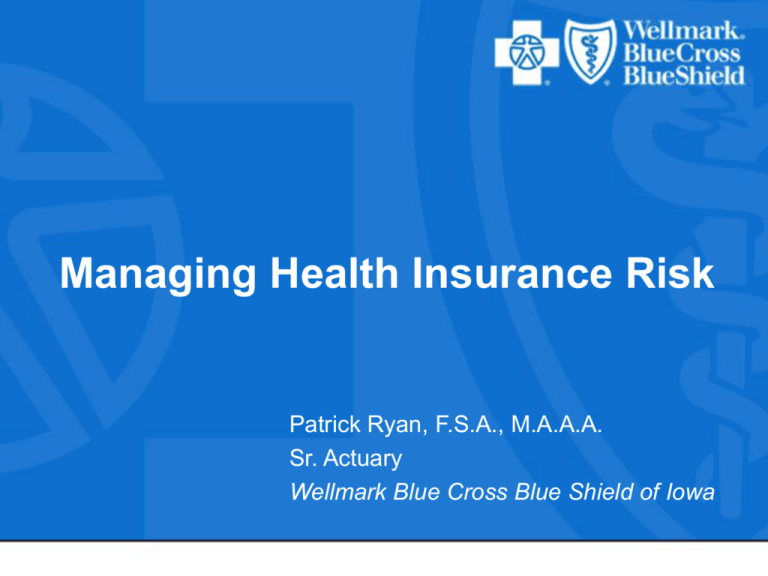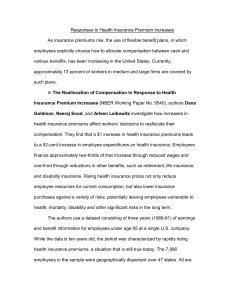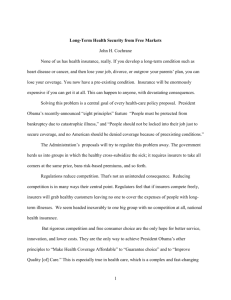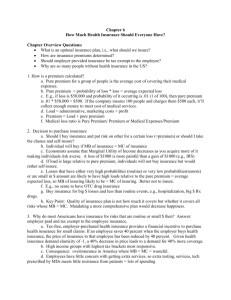Ryan Presentation
advertisement

Managing Health Insurance Risk Patrick Ryan, F.S.A., M.A.A.A. Sr. Actuary Wellmark Blue Cross Blue Shield of Iowa Managing Health Insurance Risk: Basics » It’s critical to maintain random mix of risks: • 1% of individuals generate 20% of costs • 5% of individuals generate 50% of costs • 20% of individuals generate 80% of costs » Attraction of disproportionate share of high risk will raise average costs – higher premiums for everyone 2 Managing Health Insurance Risk: Basics » Different risks have different incentives to purchase coverage Higher risks: • Sicker individuals, or individuals vulnerable to illness (i.e., older) 1) Are less sensitive to price 2) Tend to select policies with broad benefits, lower cost sharing Lower risks: • Younger, healthier individuals 1) Are highly price sensitive 2) Are less interested in broader benefits 3) Are less concerned about a higher level of medical management (i.e., an HMO) 3 Managing Health Insurance Risk: Avoiding Adverse Selection » Disproportionate share of high risks lead to the most problematic and most predictable insurance problem: Adverse Selection – As more high risks enroll, the average per member cost increases so premiums increase – The premium increases (triggered by the enrollment of relatively higher risks) triggers dropping of coverage – or a decision not to purchase – by younger, highly price sensitive enrollees – Loss of or failure to enroll younger, healthier risks results in a further increase in the average per member cost and further premium increases – This continuing set of dynamics – referred to as an Adverse Selection Spiral – leads to increasingly higher average per member costs –– and higher premiums for everyone 4 Managing Health Insurance Risk: Avoiding Adverse Selection » Insurers are constantly sensitive to the need to avoid triggering an adverse selection spiral » Insurers try to avoid triggering the adverse selection process by: 1) Trying to attract young healthy enrollees (to moderate overall costs) by adjusting premiums for younger healthy enrollees to reflect their predictably lower health care expenses (i.e., lower premiums) • Strategies that keep prices affordable by adjusting premiums for risk 2) Underwriting (e.g., turn down highest risk) and relying on broader-based funding (high risk pools) than just individual market enrollees to subsidize highest risk 5 Managing Health Insurance Risk: Making Coverage as Affordable as Possible Greatest challenge health insurers face: attracting balanced pool of risks to keep healthcare as affordable as possible Key Challenge: How to convince healthy individuals to buy insurance coverage? • Many healthy individuals: “Insurance is expensive and unnecessary” • Older and sicker individuals very motivated to buy 6 Managing Health Insurance Risk: Using Age Rating Age Rating in Individual Market: Insurers offer lower premiums to younger individuals Community Rating (CR): All ages charged same premium Age Monthly Age Rated Premium Monthly Community Rate CR if Youngest 20% Leave CR if Youngest 40% Leave 19-24 $149 $267 $301 $354 25-34 $169 $267 $301 $354 35-44 $218 $267 $301 $354 45-54 $268 $267 $301 $354 55+ $350 $267 $301 $354 C/R Increases Premiums by 79% for 19-24 Year Olds 7 Managing Health Insurance Risk: State Experience w/Community Rating Guaranteed issue and community rating can have unintended consequences: • Fewer Insured: Maine/New Jersey 50% of individual enrollees dropped coverage • High Premiums: Premium for a 25 year-old is: – $1,269/month in New Jersey – $924/month in Maine • Reduced Choice: Underwritten Iowa premium: $169/month – Lowest deductibles in NJ and Maine: $1,000; – The majority of insurers have left these states Guarantee issue encourages individuals to delay purchase until they become sick 8 Managing Health Insurance Risk: Pooling » Pooling protects individuals and small groups purchasing coverage from the extraordinarily high costs of highest risk enrollees » States have recognized this and have required all insurers to pool their small group market • States require health plans to pool all small firms and cannot vary premiums by more than a specified amount (e.g., 25% in most states) from average due to health status • A large claim for a small firm is spread over the entire pool – not just the small employer • Premiums cannot increase based on claims experience more than specified amount (e.g., 15%) • Result: In the small group market, low-risk firms pay higher premiums to subsidize high-risk firms 9 Managing Health Insurance Risk: Pooling » Some states have tried to build on the value of pooling by establishing state purchasing pools » Experience with state purchasing pools shows: • No additional pooling occurs; pooling is still at the insurer level not at the state purchasing pool level • Average per enrollee – premiums – costs in any purchasing pool is determined by health status of enrollee 10 Managing Health Insurance Risk: Effect of Pooling Arrangements State purchasing pools do not address cost drivers for premiums Provider Payment Rates Utilization Enrollees’ Health Status Benefit Package Administrative Costs Risk/Cost of Care (83-90%) Health plans negotiate on behalf of all members Risk Selection Issues: – 5% enrollees = 50% costs – 20% enrollees = 80% costs – Small employer risk volatility Marketing Agents/Brokers Billing Claims Processing Disease Management Customer Service Network Management Risk/Profit Taxes Compliance Costs 11 Managing Health Insurance Risk: Pooling Small Employers Health Plans Required to Pool All Small Employers • Health plans required to pool all small firms; cannot vary premiums by more than 25% from average due to health status • A large claim for a small firm is spread over the entire pool – not just the small employer – Premiums cannot increase by more than 15% due to claims experience Community Rating Would Increase Premiums by 30% for healthy groups Health Status NAIC Rules Community Rating Community Rate if 20% Drop Tier 1 $346 $454 $476 Tier 2 $399 $454 $476 Tier 3 $447 $454 $476 Tier 4 $526 $454 $476 12 In Conclusion Greatest challenge health insurers face: attracting balanced pool of risks to keep healthcare as affordable as possible Key Challenge: How to convince healthy individuals to buy insurance coverage? 13






